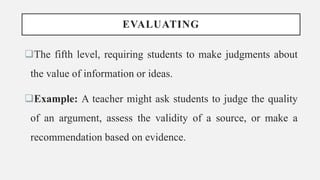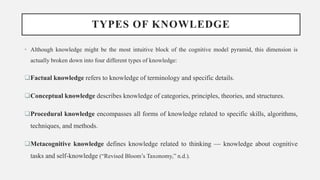Bloom Taxonomy.pptx
- 1. BLOOM'S TAXONOMY: COGNITIVE DOMAIN By Monojit Gope Research Scholar
- 2. WHAT IS BLOOM'S TAXONOMY? Bloom's Taxonomy is a classification of learning objectives that was developed by Benjamin Bloom and his colleagues in 1956. It is a hierarchical model that organizes learning objectives into six levels of cognitive complexity, from simple recall of facts to complex critical thinking and problem solving.
- 3. ORIGINAL TAXONOMY Bloom’s Taxonomy was originally published in 1956 in a paper titled Taxonomy of Educational Objectives (Bloom, 1956). The taxonomy provides different levels of learning objectives, divided by complexity. Only after a student masters one level of learning goals, through formative assessments, corrective activities, and other enrichment exercises, can they move onto the next level (Guskey, 2005).
- 4. COGNITIVE DOMAIN The original version of the taxonomy, the cognitive domain, is the first and most common hierarchy of learning objectives (Bloom, 1956). It focuses on the acquisition and application of knowledge and is widely used in the educational setting. This initial cognitive model relies on nouns, or more passive words, to illustrate the different educational benchmarks.
- 6. LEVEL OF BLOOM'S TAXONOMY(ORIGINAL) • The individual tiers of the cognitive model from bottom to top, with examples included, are as follows: Knowledge: recalling information or knowledge is the foundation of the pyramid and a precondition for all future levels → Example: Name three common types of meat. Comprehension: making sense out of information → Example: Summarize the defining characteristics of steak, pork, and chicken.
- 7. LEVEL OF BLOOM'S TAXONOMY (ORIGINAL) Application: using knowledge in a new but similar form → Example: Does eating meat help improve longevity? Analysis: taking knowledge apart and exploring relationships → Example: Compare and contrast the different ways of serving meat and compare health benefits.
- 8. LEVEL OF BLOOM'S TAXONOMY (ORIGINAL) • Synthesis: using information to create something new→ Example: Convert an “unhealthy” recipe for meat into a “healthy” recipe by replacing certain ingredients. Argue for the health benefits of using the ingredients you chose as opposed to the original ones. • Evaluation: critically examining relevant and available information to make judgments → Example: Which kinds of meat are best for making a healthy meal and why?
- 9. LEVEL OF BLOOM'S TAXONOMY(REVISED) • The six levels of Bloom's Taxonomy are: Remembering. Understanding. Applying. Analyzing. Evaluating. Creating.
- 10. REMEMBERING The lowest level of cognitive complexity, requiring students to recall or recognize previously learned information. Example: A teacher might ask students to define a word, list the steps in a process, or identify the main characters in a story.
- 11. UNDERSTANDING The second level, requiring students to demonstrate comprehension of information by explaining, interpreting, or summarizing it. Example: A teacher might ask students to explain the meaning of a concept, interpret a graph or chart, or summarize a passage of text.
- 12. APPLYING The third level, requiring students to use information in new and concrete situations. Example: A teacher might ask students to use a formula to solve a math problem, apply a scientific principle to a real- world problem, or use a historical concept to interpret an event.
- 13. ANALYZING The fourth level, requiring students to break down information into its component parts and identify relationships between them. Example: A teacher might ask students to identify the main points of an argument, compare and contrast two different perspectives, or break down a complex problem into smaller parts.
- 14. EVALUATING The fifth level, requiring students to make judgments about the value of information or ideas. Example: A teacher might ask students to judge the quality of an argument, assess the validity of a source, or make a recommendation based on evidence.
- 15. CREATING The highest level of cognitive complexity, requiring students to produce new and original ideas or products. Example: A teacher might ask students to write a poem, design a poster, or create a new product.
- 16. TYPES OF KNOWLEDGE • Although knowledge might be the most intuitive block of the cognitive model pyramid, this dimension is actually broken down into four different types of knowledge: Factual knowledge refers to knowledge of terminology and specific details. Conceptual knowledge describes knowledge of categories, principles, theories, and structures. Procedural knowledge encompasses all forms of knowledge related to specific skills, algorithms, techniques, and methods. Metacognitive knowledge defines knowledge related to thinking — knowledge about cognitive tasks and self-knowledge (“Revised Bloom’s Taxonomy,” n.d.).
- 17. BENEFITS OF USING BLOOM'S TAXONOMY Deeper understanding of the material: By requiring students to think at higher levels of cognitive complexity, Bloom's Taxonomy can help them to develop a deeper understanding of the material they are learning. Critical thinking and problem-solving skills: Bloom's Taxonomy can help students to develop critical thinking and problem-solving skills by requiring them to apply, analyze, evaluate, and create. Engaging and challenging learning: By requiring students to think at higher levels of cognitive complexity, Bloom's Taxonomy can help to make learning more engaging and challenging for students.
- 18. HOW TO USE BLOOM'S TAXONOMY Consider the level of cognitive complexity: When designing learning objectives, it is important to consider the level of cognitive complexity that is appropriate for the students' age, grade level, and prior knowledge. Use a variety of question types: When designing assessments, it is important to use a variety of question types that assess different levels of cognitive complexity. Provide feedback: It is important to provide feedback to students on their performance so that they can learn from their mistakes and improve their understanding of the material.
- 19. CONCLUSION Bloom's Taxonomy is a valuable tool that can be used to promote higher-order thinking skills in the classroom. By using Bloom's Taxonomy, teachers can help students to develop deeper understanding of the material they are learning, develop critical thinking and problem-solving skills, and make learning more engaging and challenging.
- 20. THANK YOU




















